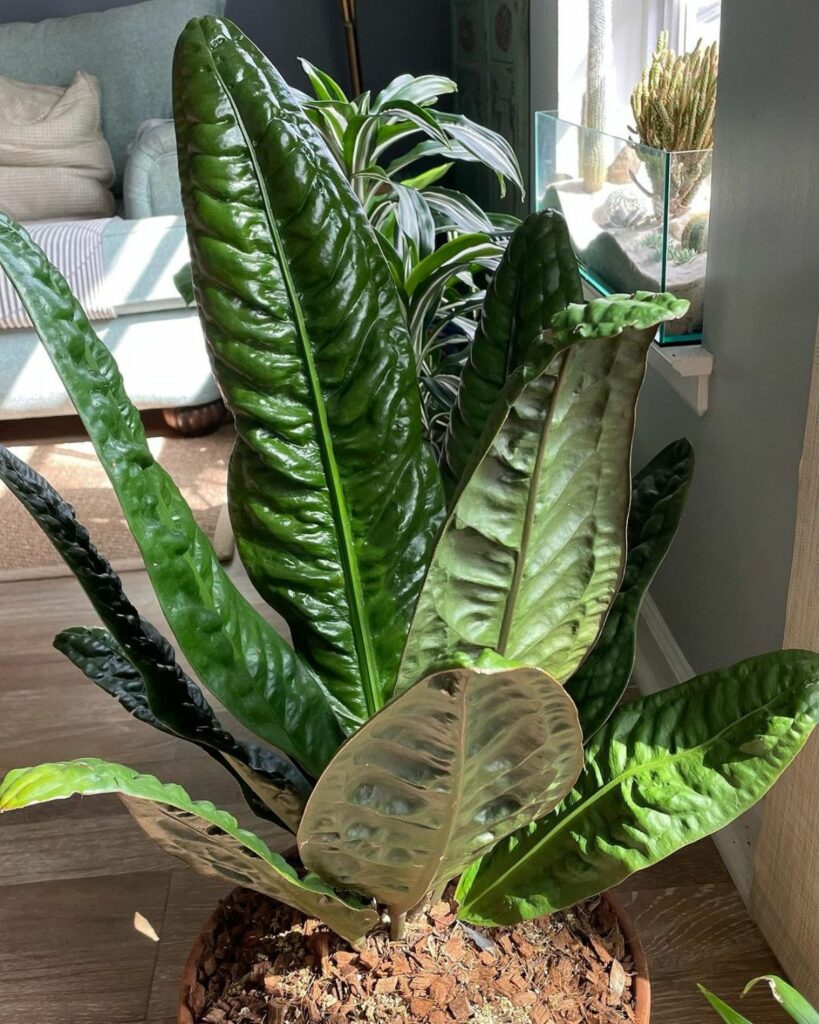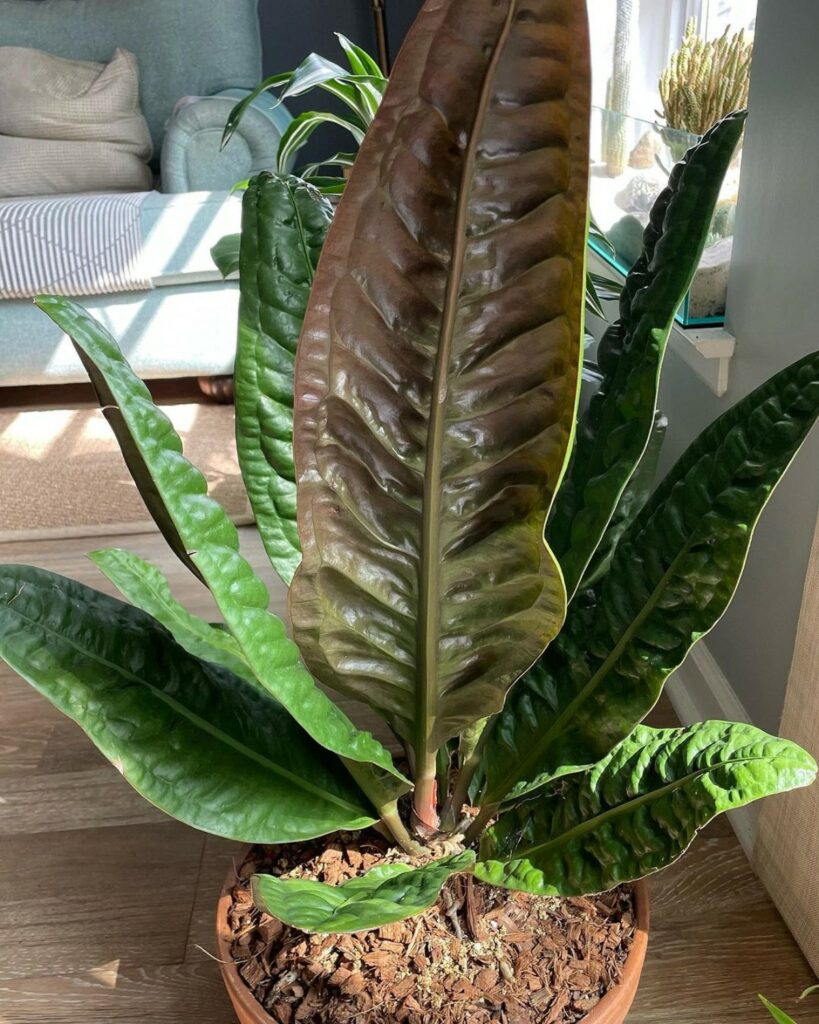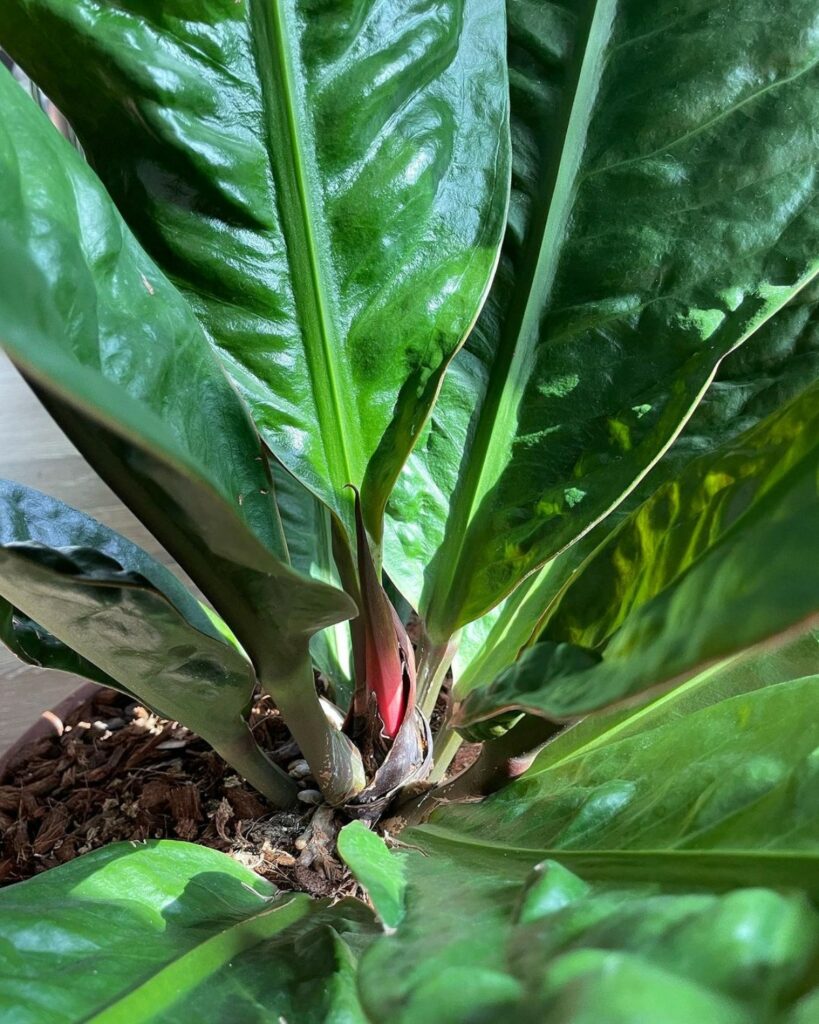Anthurium Superbum is one of the most recognizable species of the bird’s nest type. With stunning sculpture-like leathery leaves, this anthurium will transform your space.
This bird’s nest anthurium species is unlike others; it won’t take over your space as its size is manageable.
If you’ve already decided to bring this green beauty to your home jungle, you need to know how to set the optimal conditions for this plant.
You’ll find here a list of requirements and care details to help you in this venture. But don’t worry, it’s a hardy plant that won’t give you much headache.

Source: longislandplantdaddy
Anthurium Superbum Leaves
Anthurium Superbum belongs to the Araceae family and grows in Ecuador’s lowland tropical forests. It is an epiphytic type of anthurium with abundant pink roots.
Its leaves are tightly clustered and rosette-patterned, mimicking a bird’s nest. Built to capture rain, its funnel-shaped leaves act as nature’s ingenious irrigation system, channeling water to the thirsty roots and creating self-sustaining compost at its base.
New leaves unfurl in a display unlike any other. Anthurium Superbum typically sports about ten broad, leathery leaves that are a deep green and reach up to 50cm in length.
The prominent central veins create distinct furrows, and the leaves grow stiffly upright. A pronounced, sharply defined midrib runs through each leaf, with the undersides of young foliage displaying a purplish hue.
The spathe is green, the spadix cream, and the berries are lavender in color.

Source: longislandplantdaddy
Care Requirements
This is a hardy plant!!! Even if you’re a total beginner, this one is for you! It won’t go diva on you, like the warocq, for example. And it is quite affordable, so it won’t break the bank.
If you take care of it, it will reward you with steady growth. You can expect a new leaf every month when it’s happy.
While Anthurium Superbum is considered an easy plant to grow and look after, you have to be aware of a few particular requirements. Here’s what you need to focus on:
Soil
When selecting the right Anthurium soil, you have to consider how it grows in its natural habitat. As an epiphyte that thrives on other trees with minimal soil, it’s essential to mimic this environment at home by using a loose, chunky, and well-draining substrate.
You can buy a ready-made aroid mix and enhance it with chunky bark chips. The roots will thrive by attaching themselves to the large pieces of bark. Or you can create your own aroid mix. I have a guide on aroid potting mix, which you can check out.
Light
Anthurium Superbum is not very picky when it comes to light. It prefers bright indirect light but will tolerate slightly less optimal light conditions.
I used to grow my Superbum without a grow light but closer to a window where it was getting dappled light, and it was fine. Check out my anthurium light requirements guide for more information.
Water
Watering frequency will depend on your substrate and whether you grow the plant indoors or outdoors. Soak your potting mix thoroughly and water when the mix feels light or looks dry. As with other epiphytic anthuriums, the roots like moist but not soggy conditions. For a more in-depth guide on watering, check out my essential guide to anthurium watering.
Humidity
Anthurium Superbum will tolerate lower humidity, making it a perfect plant for almost any house condition. It’s not picky about humidity. Its thick, leathery leaves can hold on to moisture.
You don’t need to keep it in humidity-controlled cabinets or grow tents. But of course, keeping it near a humidifier won’t hurt; after all, it is a tropical plant.
Temperature
The ideal temperatures for anthuriums are between 60⁰F and 85⁰F, and this one is no exception. It is quite a forgiving anthurium, but you should aim to keep the temperature steady throughout the year.
Anything lower than 55⁰F can stunt its growth.
Fertilizing
This plant doesn’t need excessive fertilizing, but an NPK fertilizer with a 20-20-20 ratio (N for nitrogen, P for phosphorus, and K for potassium) works wonders. It significantly enhances the strength and vibrancy of the leaves while also helping the roots to establish. Mixing vermicast (worm castings) with the potting mix does wonders. You could also try fish emulsion if the smell doesn’t bother you. (It kind of stinks initially).

Source: longislandplantdaddy
Pest and Diseases
The corrugated leaves provide plenty of hiding places for pests. Cleaning the leaves regularly will help prevent pest infestation. Shower them now and then, or at least dust them regularly. Spider mites are probably the most common pest for the bird’s nest anthurium, and hosing down the leaves will keep them at bay.
If the growth slowed or you see any webbing or spots on the leaves, take a closer look to see if something is happening.
Root rot, leaf spot, or anthracnose are the most common anthurium diseases. Keeping the substrate too wet invites them. If left untreated, you’ll lose your superbum, so spot them early and don’t overwater.
I’ve written guides on the most common anthurium pests and diseases, so check them out. These articles will help you identify the culprit and provide a suggested remedy.
You can also check out my guide to caring for Anthurium Hookeri, another bird’s nest anthurium.
It’s a low-maintenance anthurium. Give it a try. It will bring a prehistoric Jurassic Park vibe that will brighten your mood whenever you look at it.

